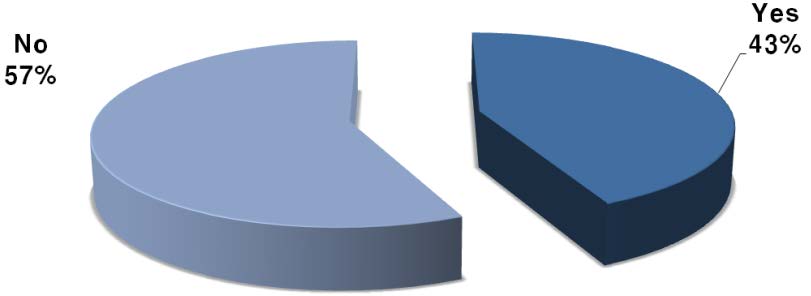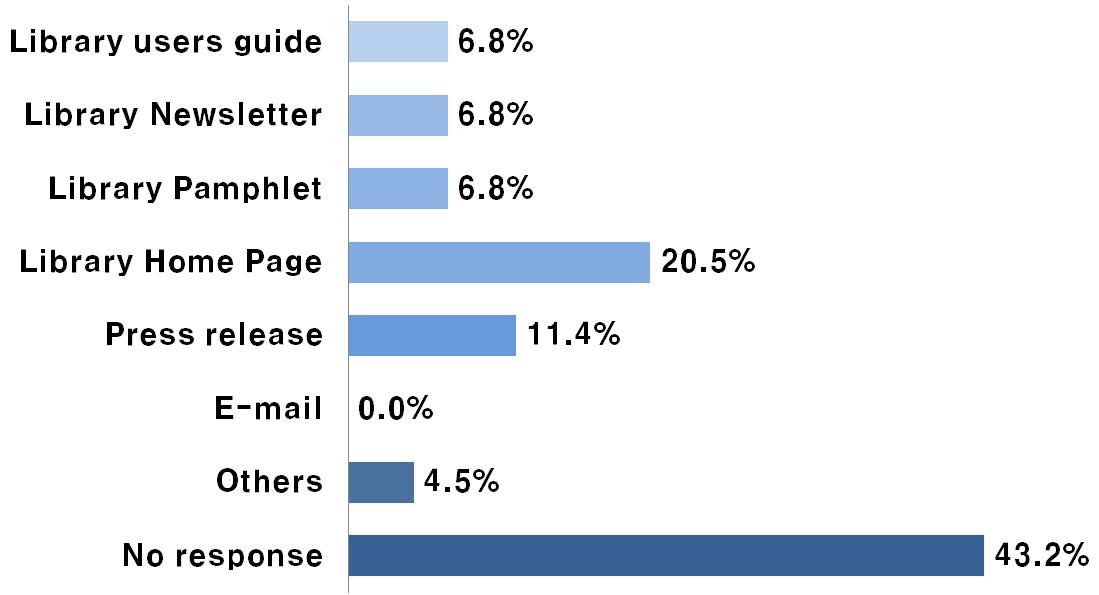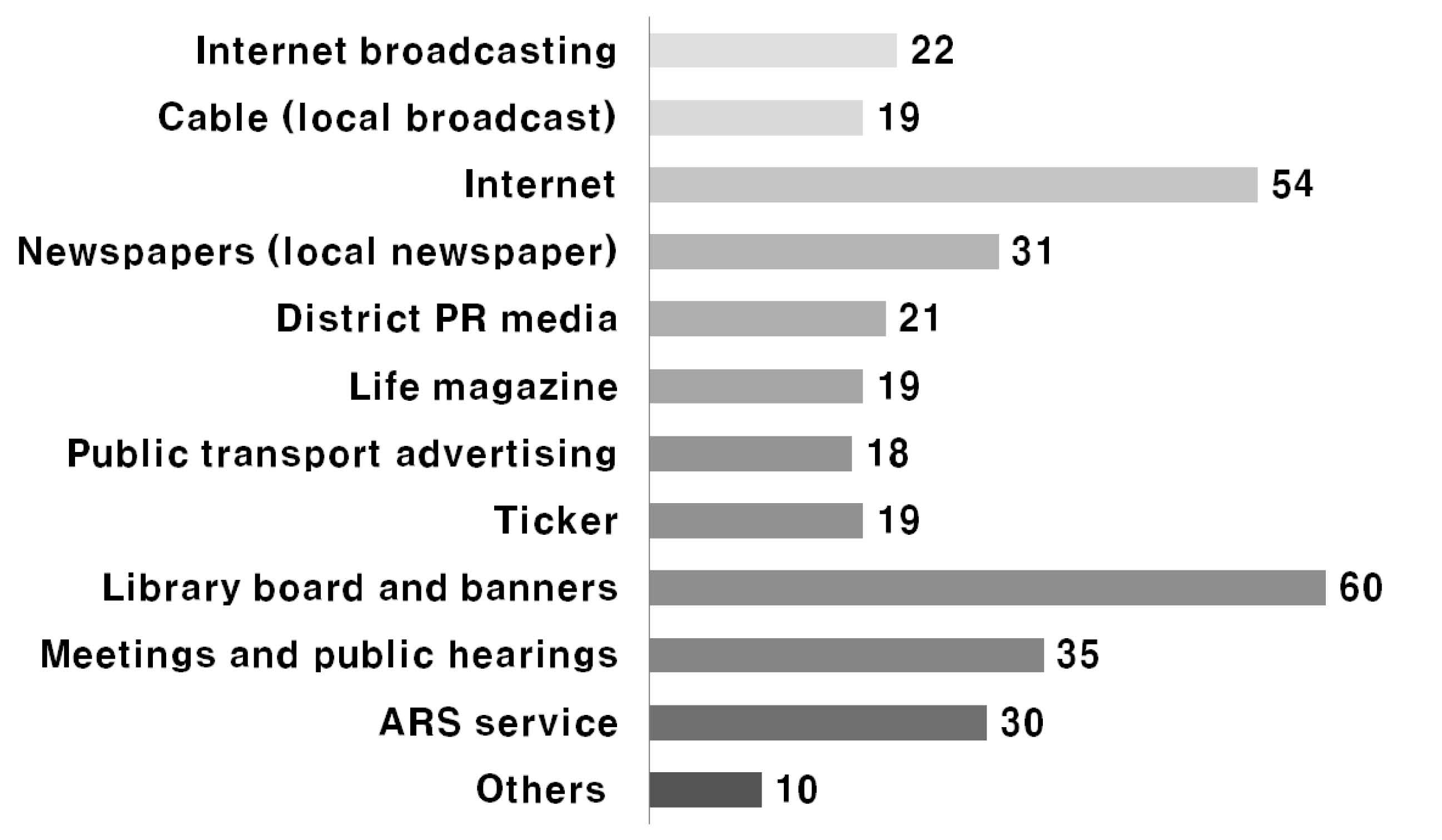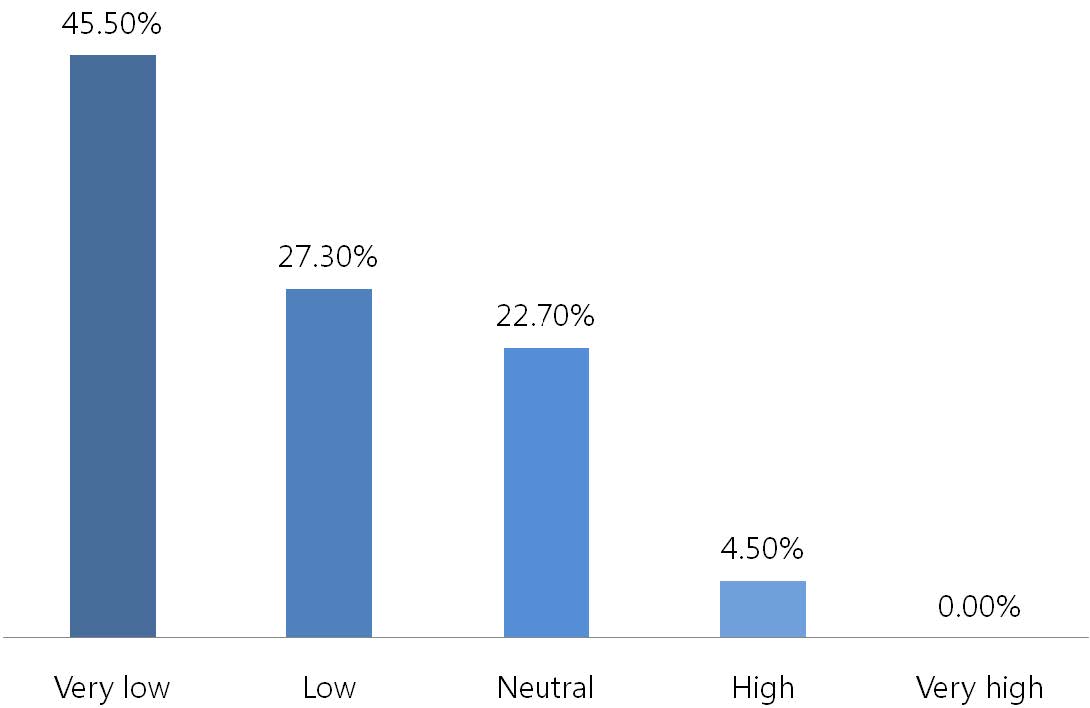
A Study on Librarian Service Providers' Awareness and Perceptions of Library Services for the Disabled
The purpose of this study is to improve library promotional marketing for the disabled by identifying requirements of public library disability services.
This study aimed to investigate librarian service providers' awareness of library programs for the disabled in order to prepare a systematic plan for promoting such library services. Research methods used are a literature analysis and survey. First, the ratio of respondents with experience promoting activities and services for the disabled was less than 50%. Second, regarding methods for promoting library disability services, the respondents used library homepages, press releases, library user guides, library newsletters, and library pamphlets in that order. Third, when asked what kind of PR media the library disability service providers had experience with and how often they use it, library boards and banners were the most common response. Fourth, suggested improvements to the current design and content of PR materials included: clearer word choice (or greater understandability), more detailed descriptions, simpler layouts, and more interesting or eye-catching content in that order. Fifth, the library disability services which are in the most need of public relations were guide information for library disability services, Library and Information Service (DOI services and search services), using alternative materials and the library collection, and aiding the information search.
Overall, when evaluating the promotion of disability services in Korea, the library's public relations for disabled services needs to improve because currently neither librarians nor the disabled community they are targeting has frequent or quality experience with it.. Thus, the policy department for the library disability services must develop a variety of promotional strategies adjusted for each type of the disability and distribute PR materials to service providers individually, making sure to utilize effective PR methods.
Keywords:
Library Disability Services, Service Provider for Disabled Users, Perception of PR, Disabled Users, Librarians' Perception1. Introduction
Library Public Relations is a series of activities in which libraries analyze and understand the needs and requirements of their users, and inform them of the library products and services which are available to meet their needs. It encompasses three elements: user need, library services and products, and marketing activities (Lee, 2007). Since research results (Idaho State Library, 1992) have shown that the need for library public relations is very high, at home and abroad, many researchers have claimed the necessity of promoting the library (Lee, 2007; 2011 Kwon, 1987; Choi, 1995; Norton, 1984). Furthermore, there is even a study that has urged the need for the marketing librarian (Noh, 2008).
In recent years many research projects have attempted to develop library services for the disadvantaged, especially the disabled. Nevertheless, research findings showed that utilization of those services is significantly lower than the investment in the projects (Noh, Ahn, & Park, 2011; National Library of Korean, 2007). Therefore, an analytical study of why disabled persons do not use the library and library services created for them was conducted. Jung and Kim (2008) found the most likely cause was that the disabled person was unaware of the services available to them. Based on the survey results, they argued that libraries need to inform users about the services more actively.
After Gillian Burrington left the library and information science profession due to blindness, she recorded his feelings and experiences using the library services for disabled persons (Burrington, 2007). She pointed out that if the disabled community is not informed about the services available to them, those services are meaningless, despite the great effort libraries expend to provide them. When viewed from a comprehensive analysis, the library is developing a variety of services for people with disabilities and performs a variety of activities for them, resulting in high user satisfaction. Nevertheless, these useful services are not being utilized due to lack of publicity.
Another problem is that most of the research claiming the necessity of promoting has been done in terms of the users' side; namely, they are focused on why users do not use the library and what difficulties are involved in coming to the library and using the library services.
This study is targeted at both disability service providers and disability services librarians, and is aimed at better equipping librarians to inform the public about the variety of services for people with disabilities as well as finding practical methods for users to use those services.
2. Related Studies
PR (public relations) is often called Publicity, Promotion, or CR (community relations). In general, public relations provides managers with information for a variety of changes in public opinion, which is useful for deciding how they should change their image based on public opinion. PR also promotes business by exchanging information so that the organization and the public can interact more smoothly (Lee, 2007).
Library public relations is defined as a series of activities which informs customers about the products created to meet their needs based on data analyzing users' requirements. Elements contained in it are the user demand, library items, and informing activities.
The literature begins with studies introducing the concept of library public relations, and insisting the necessity of PR. Stueart and Moran (1987) insisted that library public relations is the process of persuasion to gain public support in order to achieve the purpose of the library; conscious and aggressive promotional activities lead the public to have an interest in the library and its service. Therefore, promotion of public libraries will show the best results when it is utilized in harmony with the many other different business activities which libraries plan and operate, not as a separate area.
In 1992, Idaho State Public Library (1992) conducted a survey on public relations targeting library directors and librarians. They discovered that most respondents were aware that publicity relation is important, but only 3 percent were satisfied with their library's promotion plans. In addition, 75 percent of the respondents reported a lack of publicity budget, and 76 percent of surveyed libraries have one employee performing public relations activities. The newspaper was the most preferred among many other promotion media.
Lee (2007) said that professional libraries in the 21st century knowledge-based era are facing a competitive environment. Therefore, libraries have to conduct ‘library marketing’ towards affiliated institutions and customers for the continuation and development of the library. He presented various marketing strategies for Korean professional libraries, based on analyzing cases of marketing practices at home and abroad. Lee (2011) also conducted research on the ‘Family Place Library’ programs offered to the local community by the children's services departments in US public libraries. In February 2011, about 300 US public libraries participated in the ‘Family Place Library’ program for toddlers and their families. This study focused on the public libraries providing these programs in the US state of New York, analyzed its main contents, and conducted in-depth interviews with experts. Based on these findings, he suggested marketing strategies for public library management.
Kwon (1987) sought to investigate methods to maximize marketing effects by systematizing the marketing activities that have been passively applied by library management. Lee (1996) presents the public library's new and improved scope of service with emphasis on dynamic information service to maximize interests of the local community in an ever-changing environment of competition and globalization. This study also presents a new goal to help overcome the financial difficulties arising in advanced countries by introducing marketing concepts to the operation of public libraries.
Oh and Noh (2003) apply marketing strategies to the Electronic Information Center in the S Library, contributing techniques to create a dynamic approach to overall strategy development for library professionals that will ensure effective management and goal achievement. Han (2003) examines the necessity for library marketing, the importance of Internet marketing and plans for its application, and suggests strategies for market segmentation in libraries.
Chung and Kim (2008) aimed to analyze the use and needs of library services for disabled persons with a survey designed to measure library marketing effectiveness. The survey data revealed that the majority of disabled persons did not visit the library and had no experience with library services. Therefore, the study concluded that active guidance and public relations about library services needed to be improved. Some suggestions for this goal included: improvement of accessibility for the disabled by building digital collection, resource sharing and an extension of services by building library cooperation network, and training librarians in how to best help the disabled.
Burrington's 2007 article is a personal account of the challenges faced by a library school lecturer who lost her sight later in life. It illustrates the difficulties faced by the visually impaired in the United Kingdom in obtaining access to reading materials for professional, educational, and leisure purposes while also considering their future prospects. Beaton (2005) said that a great challenge for the public library is to offer services to its large and diverse body of disabled users, who may need to use any part of the public library system at any time, and whose needs must be anticipated. He sketches how one particular public library attempts to meet that challenge, and he offers clearly described models for service delivery to disabled users which will be of great interest to those in public library management and library practice.
3. Research Questions
As we have seen discussed above, policy development, long range development planning, and many research studies, which attempted to improve library services for the disabled, have highlighted the need for public relations strategies. However, studies to develop concrete PR strategy for improving and advertising these services need to be done separately and independently of the previous studies. Thus, studies from many different angles will be able to contribute to improving library services for the disabled as a whole.
In this study, we investigate the current status of library service PR for the disabled and library services providers' perceptions by performing a literature analysis of case studies and a survey. The research questions posed in this study are as follows:
RQ 1: Do librarian service providers for the disabled have any experience with library PR for them? And if so, what kind of media do they have experience with?
RQ 2: Do library service providers for the disabled have interest in PR media? If uninterested, in which direction should PR media be improved?
RQ 3: What do library service providers for the disabled think are ways to strengthen library promotional marketing?
RQ 4: What library services do the librarians think are most needed among the disabled community?
The survey was developed to address the above research questions and attempt to discover answers
during the course of response analysis.
4. Research Design and Methods
This study aimed to investigate the awareness of service providers to prepare a systematic plan for promoting library services for the disabled. Research methods used were literature analysis and survey.
First, owing to recent increased interest in disability services, we analyzed the literature regarding the disabled person's access to information and addressing this digital divide in the rapidly changing knowledge-based society. Through this, we attempt to diagnosis the current service status and determine the service level for the disabled in both domestic and international libraries.
Second, we surveyed library service providers who work with the disabled. Through the survey, we investigated whether or not they had PR experience, what if any promotions the library was currently doing, in what ways the library's promotional contents could be more effective, other strategies to enhance the promotion of library services, and which library service area most needed promoting.
4.1. Data Collection Procedures
We selected the survey recipients by type of disability for which they provide service. As a result, a total of 44 respondents were selected for each type of disability. In Korea, there are few librarians who provide service for the disabled, so it was very difficult to find librarian survey recipients. We used the snowballing method for selecting the survey recipients.
4.2. Survey questions and configuration
Questions in the survey used in this study were written by referring to the existing research and questionnaires that highly related to general PR research and practice, library services for the disabled, and library PR aimed at the disabled. Finally, a questionnaire consisting of a total of eight entries was compiled, including personal background information. The configuration and items of the questionnaire are shown in the following <Table 1>.
4.3. Data analysis methods
Data SPSS statistical package for data analysis (SPSS 18.0 K for Windows) was used. The frequency analysis and descriptive statistics for each survey question were calculated. In addition, the cross-analysis of the questions about the respondents' age and duration of employment was conducted with other questions.
5. Results
5.1. Whether the library promotes disability services
For the survey question asking the respondents whether or not they are doing promotional activities for library disability services, 19 (43.2%) of a total 44 respondents, answered ‘Yes’ while the remaining 25 respondents (56.8%) said ‘No’. This means that less than half of the librarians were experienced in promoting disability services even though they are all providing that service.
We analyzed the difference based on duration of employment by using the cross-analysis, and the results showed that the longer duration of work meant a greater experience in public relations, as shown in <Table 3>.
5.2. Methods for promoting disability services
For the question asking the respondents about how to promote library disability services, among the 25 respondents excepting the non-responses (43.2%), library website was the highest (20.5%), followed by press releases (11.4%), library user guide, library newsletter, library pamphlet(all 3%). None of the respondents used email as a promoting methods.
5.3. Their experienced PR media and the frequency of such experiences
For the question asking the respondents about their experienced PR media and the frequency of that experience, we calculated the total score by rating very high frequency (5), high (4), medium (3), low (2), and very low (1). As a result, library board and banners showed the highest score of 60 points, followed by the internet (54), meeting and public hearings (35), the newspaper (local newspaper) (31), and ARS Services (30). On the other hand, public transportation advertising, wired (local broadcast), life magazine, and billboards appear to be relatively infrequently utilized as promoting media with less than 20 points.
5.4. Suggestions for more Effective PR Materials
For the question asking the respondents about the direction future PR contents and materials should take to be more effective, the ratio of respondents insisting that the configuration of PR contents must be organized more clearly was the highest. The respondents insisting that materials should be provided in more detail (22.7%), organized more simply (20.5%), and organized more entertainingly (13.6%) followed in that order. There were also other respondents insisting that the users' accessibility must be increased.
5.5. Assessment of PR marketing for library disability services
For the question asking the respondents about their assessment of PR marketing for library disability services, 20 respondents (45.5%) assessed very low, 12 respondents (27.3%) low, 10 respondents (22.7%) medium, and 2 respondents (4.5%) high. None of the respondents answered very high. In other words, 72.8% of the respondents assessed PR for disability services very low. Therefore improvements in promoting and marketing library disability services are needed.
5.6. Methods for strengthening Public Relations marketing for library disability services
The most often chosen requirements to strengthen the promotional marketing for the library disability services were a variety of promotional media (32.6%) and cooperation with related institutions (26.3%), followed by enhancing the professionalism of public relations organizations (18.9%), public relations budget expansion (13.7%), and establishing and reorganizing the PR department (7.4%). Other opinions included ‘user consultation and sending DM (direct messages)’.
5.7. The library service area in most need of promotion
For the question asking the respondents about the most library service area in most need of promotion, we calculated the total score by ranking the results thusly: very high frequency (5), high (4), medium (3), low (2), and very low (1). As a result, guide information for library disability services showed as the service requiring the greatest PR with a score of 193, followed by Library and Information Service (DOI services and search services) (163 points), using alternative materials and library collection (158 points), and aiding the information search (152). Other opinions included the location of ramps for wheelchairs, easy transportation to the library, and events during which people with and without disabilities read books together.
6. Discussion and Conclusion
In the above section, we summarized the survey results and suggested various methods to strengthen promotional marketing for library disability services. The results are as follows:
First, the ratio of respondents that experienced promotional activities for the library disability services was less than 50%. The results showed that a longer duration of work experience was related to a greater experience in public relations. This low promoting experience may explain the fact that library disability service is widely available in Korea but its utilization seems too low. Also we can expect that the PR experience of users using these services would in turn be lower.
Second, as methods for promoting the library disability services, the respondents used library homepages, press releases, library user guides, library newsletters, and library pamphlets in order. None of the respondents used email as a promoting method. Even though 6 promoting methods were presented as questionnaire items, respondents' PR activities were centered on the library homepage, rather than take advantage of a variety of promotional methods. Therefore, it is highly needed for librarians to use popular communication methods (Wikis, Blogs, Twitter, Facebook, etc.), and develop very concrete PR methods appropriate for each type of disability.
Third, in the results of analyzing what kind of PR media the library disability service providers’ experience, and how often they use it, library board and banners were highest, followed by the internet, and meetings and public hearings. On the other hand, public transportation advertising, radio or cable (local broadcast), life magazine, and billboards appeared to be relatively infrequently utilized for promoting. However, the library board or banner is inaccessible for the visually impaired, therefore this result emphasizes the importance of developing PR methods adjusted for each type of disability.
Fourth, to improve the design and contents, PR materials should be more easily understood, more detailed, utilize simpler configurations, and be a little more interesting in that order. Another important opinion was to increase the users' accessibility based on their disability type. Therefore, we can suggest that an understanding of disabled users and identifying their needs and degree of literacy are both highly needed. In addition, it was discovered that the library disability services providers rated the current promoting and marketing as a whole very low (Low and Very Low is 72.8%).
Fifth, to improve the promotional marketing for library disability services, the development of various promotional media, cooperation with related institutions, enhancing the organization's expertise, increasing the public relations budget, and establishing and reorganizing the PR department were found to be necessary in that order. Therefore, the development and improvement of PR media and strategy, and cooperation with welfare agencies must be priorities in order to activate promotional marketing and increase satisfaction with it.
Sixth, the library disability service areas in which public relations is most needed were guide information for library disability services, Library and Information Service (DOI services and search services), using alternative materials and the library collection, aiding the information search, awareness about libraries’ identity, library cultural events and programs, and local information service in that order.
Overall, when evaluating the promotion of disability services in Korea, the library's public relations for disabled services is very poor (very low scores), and disability service providers public relations experience is very low. On the other hand, the awareness of a definite need to develop promotional marketing was very high. The requirement for development and improvement of a variety of promotional strategies was very high, both internally and externally for a variety of promotional strategies. Thus, the policy department for library disability service has to develop a variety of promotional strategies adjusted for each type of disability, distribute to service providers individually, and utilize effective PR methods.
Acknowledgments
This work was funded by the National Library of Korean. The author thanks Patricia Ladd for editing this article into fluent American English.
References
-
Beaton, M., (2005), Glasgow City Council: library. Information and learning services for disabled people in Glasgow, Library Reviecw, 54(8), p472-278.
[https://doi.org/10.1108/00242530510619174]

-
Burrington, G. A., (2007), A user's perspective, Library Trends, 55(4), p760-766.
[https://doi.org/10.1353/lib.2007.0037]

- Choi, S. K., (1995), On the Marketing Strategies of Special Libraries, Journal of Korean library and information science society, 23, p147-182.
-
Chung, Y. K., & Sung, J. K., (2008), A study on the library service use and needs of disabled users in korea, Journal of the Korean Society for Library and Information Science, 42(3), p302-323.
[https://doi.org/10.4275/KSLIS.2008.42.3.301]

- Idaho State library, (1992), Survey Results: Idaho Public Relation Practices, Idaho State Library.
- Lee, M. S., (2007), A Study on the PR Strategy of Public Library, Journal of Korean library and information science society, 38(1), p3-28.
- Lee, Y. J., (2007), A study on the marketing management strategy of special libraries in Korea, Journal of Korean library and information science society, 38(3), p335-351.
- Lee, Y. J., (2011), A Study on Children Service Marketing Strategies of Public Libraries: With Special Reference to ‘Family Place Library’ at the Public Libraries in USA, Journal of Korean library and information science society, 42(1), p417-440.
- Noh, Y., (2008), A Study on How to Foster Marketing Librarians, Journal of Korean library and information science society, 39(1), p169-194.
- Noh, Y., Ahn, I., & Park, M., (2011), A study on developing the recommended standards and management guidelines of library goods, Journal of information management, 42(3), p117-145.
- Norton, A., (1984), Library public relation, new opportunites in a growing Field, Library Trends, 32(3), p291-302.
-
Oh, K. M., & Noh, Y. J., (2003), A study on marketing strategy for facilitating electronic information services in the public library, Journal of Korean library and information science society, 20(3), p261-276.
[https://doi.org/10.3743/KOSIM.2003.20.3.261]

- Stueart, R. D., & Moran, B. B., (1987), Library Management, Littleton, CO: Libraries Unlimited.
- The National Library of Korea, (2007), National library disability services Survey, Seoul: The National Library of Korea.







